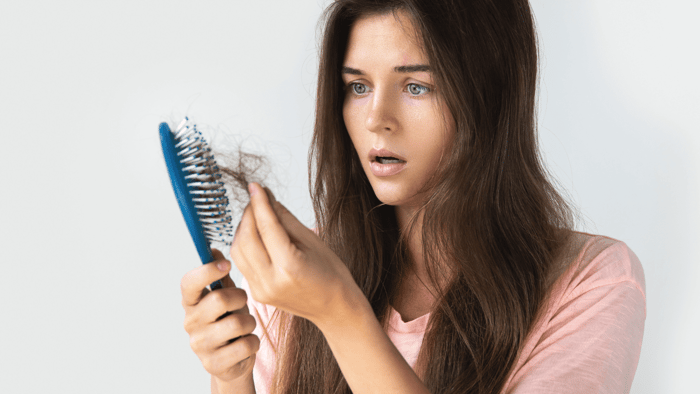
When we think of hair loss, we usually picture men—especially if it’s age-related. Despite all the male-targeted ads and remedies, though, women make up a significant portion of those plagued by this condition.
The American Hair Loss Association estimates that around 40% of hair loss sufferers are women. Still, many will stress about it behind closed doors, even when there are plenty of options to explore.
If you have clumps in your hairbrush and a scalp that is more noticeable than you’d like it to be, you don’t have to live with it. There are treatments (and even hairstyles) that can help. Keep reading for more information on female baldness and what you can do to intervene.
An Overview on Hair Loss
Our hair grows in a three-phase cycle:
- In the anagen phase, hair strands are still actively growing.
- In the catagen phase, hair ceases to grow and prepares to shed.
- In the telogen phase, the follicle sheds the hair.
After the telogen phase, the hair follicle remains dormant for around three months. Following that, it begins to sprout new hair and continues the cycle.

When this cycle gets disrupted, that’s when hair loss or thinning can take place. Telogen effluvium causes excessive shedding and anagen effluvium leads to a halt in regrowth. Women can also experience hair loss due to androgenetic alopecia, or female pattern baldness.
While we can give general estimates about hair loss, the fact is that everyone experiences it differently. It’s normal to lose between 50 to 100 hairs per day, but some might lose more (or less). If you’re losing more than what’s normal for your hair, now is the time to intervene.
What Causes Female Baldness?
Just like with men, certain conditions and abnormalities can contribute to hair loss in women. Below are some of the most common causes of female baldness.
Genetics
Just as we inherit our hair type and color, we also inherit the possibility of becoming prematurely bald. This most often applies to female pattern baldness but can contribute to other causes as well.
Hormones
Certain hormonal conditions impact hair loss, especially in women. Hypothyroidism, where thyroid hormone levels are abnormal, can have hair loss as a symptom. Hormonal shifts during menopause can disrupt hair growth as well.
Androgenetic Alopecia
Androgenetic alopecia is one of the most common causes of hair loss in both men and women. Also known as female pattern baldness, androgenetic alopecia generally causes widespread thinning of hair across the scalp. However, the hairline does not recede as it does with male pattern baldness, and the condition rarely causes the woman to go completely bald.

Medical Issues
In some cases, female hair loss can arise from a medical issue.
For example, an autoimmune condition known as alopecia areata can also cause hair loss, usually in large patches on the scalp. Disorders coming from insulin resistance, such as diabetes or obesity, could also be to blame.
Other medical conditions that can cause hair loss include:
- Anemia (low iron levels in the blood)
- Certain infections
- Lupus and other autoimmune diseases
- High fever
- Ringworm and other fungal infections
- Thyroid conditions
Treatments or Medications
Certain medical treatments could be why you’re experiencing hair loss. These include:
- Chemotherapy and radiation for cancer treatments
- Birth control pills
- Blood thinners
- Gout medications
- Lithium
- Beta-blockers
- Certain steroids
If you suspect any of your treatments or medications are causing your hair loss, it’s important to discuss alternative options with your doctor. The good news is that many of these do not result in permanent hair loss. Once you stop the treatment, the hair should eventually return to normal.
Sudden or Ongoing Stress
Stress does a number on your psyche —and it could even affect your physical health on top of that. Everyday stressors can cause higher-than-normal clumps in your hairbrush or shower drain, so it’s important to keep these in check.
Sudden, singular traumas can also lead to hair loss. A specific condition known as telogen effluvium causes hair loss after an extremely traumatic event, such as the death of a loved one. Childbirth can trigger this condition as well.
Poor Nutrition
Studies have linked certain nutrient deficiencies to hair loss. Some common deficiencies include:
- Protein
- Fatty acids
- Zinc
- Iron
Harsh Hair Styling
Unfortunately, your much-loved braids and tight ponytails could be the reason why you’re experiencing hair loss. Harsh processing methods like permanents and relaxants can contribute too.
Symptoms of Female Hair Loss
- Patches of missing or thinning hair on the scalp
- A gradually widening part on the top of the head
- More fallen hairs on your pillow, hairbrush, shower, or other areas of your home
- A thinner ponytail
- A scalp that is visible through the hair
- Weak or breaking hair
Preventing Hair Loss

Hair loss isn’t something you have to watch happen to you. Below are some easy ways to minimize your hair loss.
Be Kind to Your Hair
It might be a good idea to ditch the harsh processing and tight hairstyles, especially if you’re noticing hair loss. Embrace your natural hair, or talk to your stylist about less-damaging styles.
Maintain a Healthy Diet
If your hair loss is a result of nutrient deficiency, including those missing nutrients in your lifestyle could make a major difference. Eating a biotin-rich diet may lead to thicker, healthier hair as well. Your doctor can help fill you in on any nutrients you’re lacking.
Manage Stress
If you’re constantly spread too thin, this could be contributing to the fewer hairs on your head.
You can try a relaxation and sleep wellness kit featuring essential oils, bath bombs, and other tools to promote better sleep and stress management. Exercise, meditation and sauna bathing are some other great ways to keep your daily stress in check. In any case, the most important part is finding what works for you.
Hairstyles to Camouflage Hair Loss

Hair loss can be devastating for anyone, but women can feel especially self-conscious about it. Don’t lose hope, though: if you’re not happy with what you see in the mirror, these styles could be your next go-to.
Pin Your Hair Up
The bobby pin is mightier than the hair tie when it comes to disguising hair loss. Grab fuller sections of hair and pin them over the thinning areas. Be sure not to sleep in this style, though, as it could lead to breakage.
Switch Up Your Part
If you find patchy areas or a widening part, try changing up where you part your hair. In many cases, you might find a more flattering area. Train your new part by wetting the hair or pinning it in place.
Try a Top Knot
If your hair loss is mostly near your crown, a top knot might be just the style to cover it up. For a more laid-back look, gently pull out a few face-framing wisps.
Consider Bangs
Bangs are another great way to disguise hair thinning at your crown. Talk to your stylist about a flattering fringe for your face frame.
Try Root Coverage Products
There are many powders and spray-on colors that can cover a too-wide part and make your hair look fuller. Ask your stylist for recommendations.
Find Treatment Today
While there are many ways to intervene when you’re experiencing hair loss, these can only go to certain lengths. If you find yourself needing more, you have other options available.
Contact us today if you would like to set up a consultation with a hair replacement or regrowth specialist and learn more about what you can do to get hair loss under control or even reverse it.



